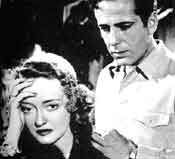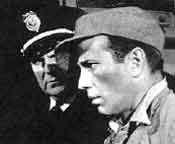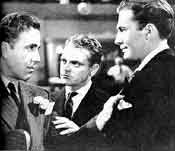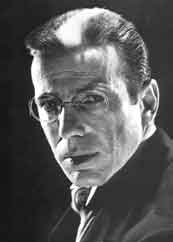|
Film by Year Film by Title |

1939 Bogart as the sinister Marshall Quesne in The Return of Dr.X (1939). Bogie's only venture into Science Fiction portrays him as Dr. Xavier who had been executed then brought back to life. He leaves a trail of murders as he seeks out a rare blood type needed to keep him alive. In Bogart's first 11 movies he dies in 9 of them - hardly the romantic hero we mostly remember him as in later escapades.

Cagney went at this role with a grand sense of humor and sparked every scene with something extra to watch for. He and Bogart did their best with what they had to work with and the result is campy western something-or-other. Bogart, dressed in black, does some of his best craven sneering. Cagney, who Bogart said later looked like a mushroom in his 10-gallon hat, looks like he trying hard not to laugh as he gaily goes about the business of revenging his father's death at the hands of Bogart's henchmen. Bogart has the funniest line in the film: as he sends one of his cowboy goons to bring Cagney to him, he says, "Tell that little squirt over by the piano that I want to see him." Watch carefully and see if Bogart can keep a straight face!

In one the the best remembered films of the thirties, Bette Davis as Judith Traherne, the dying wealthy Long Island playgirl. Humphrey Bogart plays Michael O'Leary, an Irish horse trainer with somewhat less conviction, although George Brent gives his finest performance as Dr. Frederick Steele, whom Judy eventually marries. Ronald Reagan plays the weak, drunken Alex, one of Davis's swains. Davis is magnificent throughout; her Judy is wild, spoiled and cheeky in the beginning and her amazing metamorphisis to a vibrantly happy and humbled young married woman is fascinating to observe on film.
 Bogart is a hardened criminal who takes on young Halop as his apprentice in stealing. They start with the robbery of a gas station, which goes according to plan. Halop is ecstatic over the thrills and rewards of his new career, and objects little when Bogart orders him to go out and steal a pistol for their next job. Halop takes the gun belonging to Stephens, his sister's fiance. He and Bogart stick up a pawnshop, and when things don't go as planned, Bogart shoots the proprietor. The bullets are traced and Stephens is arrested, quickly convicted, and sentenced to death. Halop wants to confess, but Bogart terrorizes him into silence. Later, Halop and Bogart are arrested when they try to steal a car, and they are sent to Sing Sing. In prison, Halop is befriended by Travers, the kindly old prison librarian, who tries to persuade the boy to confess. When Bogart learns of this, he forces Halop to accompany him and two other convicts, Downing and Huber, in an escape attempt. Bogart plans to murder the boy first chance he gets. As they begin their move, Halop drops a piece of paper with a full confession in Travers' cell. The breakout fails, the other two men are killed, and Bogart and Halop are cornered in a boxcar. Bogart confronts Halop with the confession he recovered from Travers' cell, and, after hiding it, he shoots the boy down while the police outside shoot at the boxcar. Bogart then walks out of the boxcar with hands up and tells the police that they killed Halop. Halop isn't quite dead, though. He recovers the confession and tells the whole story to the warden before dying. Stephens is pardoned and Bogart is sent to the chair instead. Hardly the most memorable film of Bogart's career, but well-done in the usual craftsmanlike manner of Warner Bros. Halop is good, too, in another of the juvenile-delinquent-with-a-heart-of-gold roles he first played in DEAD END and which he was forced to repeat through innumerable Dead End Kids and Bowery Boys movies. There are a number of good performances, particularly by Stone and Travers. Most importantly, though, Bogart does his usual tough gangster in his usual tough manner, and that is always worth watching.

Humphrey Bogart has another one of the bad guy gangster roles that he had a lot of in the Thirties. The film takes sort of a documentary approach to the era of Prohibition, from its beginning to its finish after fourteen years. At the same time, it chronicles the rise and fall of a gangster played by James Cagney, who becomes a big shot, only to lose it all. Priscilla Lane is the idealized love of his life who can never return his love because of her dislike for his lifestyle. Gladys George is excellent as Panama Smith, a speakeasy hostess who really is Cagney's soulmate, even though he doesn't realize it.

Humphrey Bogart said of this film: "This is one of the pictures that made me march in to Jack Warner and ask for more money again. You can't believe what this one was like. I had a part that somebody like Béla Lugosi or Boris Karloff should have played. I was this doctor, brought back to life, and the only thing that nourished this poor bastard was blood. If it had been Jack Warner's blood, or Harry's, or Pop's, maybe I wouldn't have minded as much. The trouble was, they were drinking mine and I was making this stinking movie." While he did not like making this movie it is a Bogart classic, and should be seen by all Bogart fans!

Please submit your review of this movie Want you own copy of these films? Click on the links above or below for information and secure online ordering. Most films are on VHS, some on DVD, and different Bogie posters are also available.
This website is the personal tribute
to Humphrey Bogart
|


